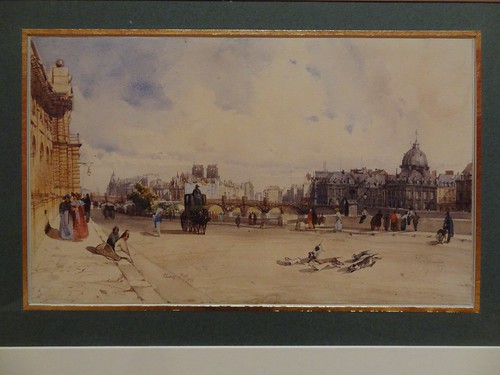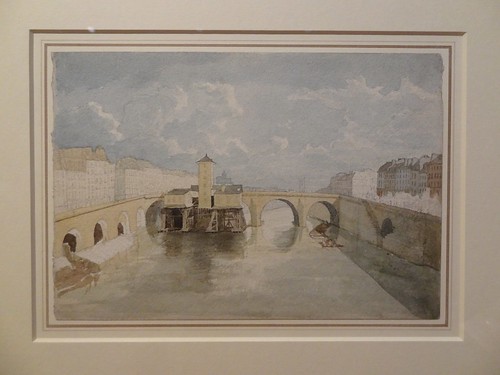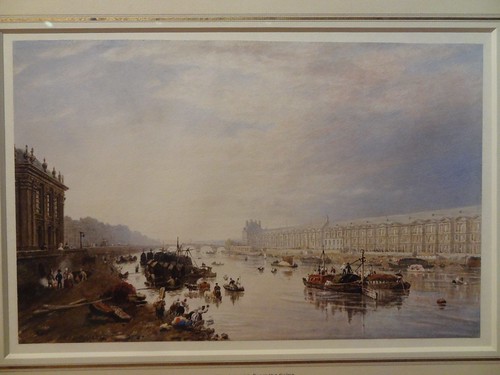Watercolour is a remarkably unforgiving medium of art. If you make a mistake, you cannot easily rectify it. With oils, you can paint over, or possibly even erase. Still, in the 19th century, oils were considered the higher art form. Neither the academy nor the cognoscenti gave watercolour the standing it deserved.
Luckily, this lack of encouragement did not hold the masters back. Entire hordes of British artists got into the habit of using watercolours. When war and time permitted, they would traipse off to lovely parts of Europe to paint. In the early 19th century, a bevy of them headed to Paris. Much of their work can be seen at the Wallace Collection's The Discovery of Paris - Watercolours by Early 19th Century British Artists - an exhibition that runs till September 15, 2013.
I was there the other day. The artworks were displayed in two not-too-large rooms. Many were by painters I hadn't heard of. I am glad indeed to be introduced to them.
The British didn't quite take to Paris. For them, when they weren't mooning over London, Venice was still the cynosure of cityscape. In France, the British appeared even to prefer Rouen to Paris. Although they appreciated the light and the architecture of Paris, and they admired it as a city of pleasure, they disdained its filth and open gutters. For most British painters of Paris, the city was the source of only a small fraction of their outputs.
For Thomas Shotter Boys (1803-74), Paris was of signal importance. He was great friends with Richard Parkes Bonington (1802-28), and they often painted vistas from similar viewpoints. His painting of the Pont des Arts shown below is, in fact, closely akin to Bonington's own earlier composition.
Louis Francia (1722-1839) was native to Calais, but spent years in England as a master and watercolorist. When he returned to Calais, he taught the likes of Bonington ('[Paris is] this city of mud and dirtiness') and William Wyld.
Another artist was John Gendall (1789-1865). He was sent by a publisher (Rudolf Ackermann) to prepare watercolours for a book, Picturesque Tour of the Seine, from Paris to the Sea (1821). The work below by Gendall was based on a sketch by Auguste Pugin.
Frederick Nash (1782-1856) was a specialist of architectural views, and he liked to add some verisimilitude by including washerwomen and charcoal burners in some of his paintings. His view of the Seine looking towards the Louvre below was part of a series of illustrations executed for a major book Picturesque Views of the City of Paris and its Environs.
For Thomas Shotter Boys (1803-74), Paris was of signal importance. He was great friends with Richard Parkes Bonington (1802-28), and they often painted vistas from similar viewpoints. His painting of the Pont des Arts shown below is, in fact, closely akin to Bonington's own earlier composition.
Louis Francia (1722-1839) was native to Calais, but spent years in England as a master and watercolorist. When he returned to Calais, he taught the likes of Bonington ('[Paris is] this city of mud and dirtiness') and William Wyld.
Another artist was John Gendall (1789-1865). He was sent by a publisher (Rudolf Ackermann) to prepare watercolours for a book, Picturesque Tour of the Seine, from Paris to the Sea (1821). The work below by Gendall was based on a sketch by Auguste Pugin.
Frederick Nash (1782-1856) was a specialist of architectural views, and he liked to add some verisimilitude by including washerwomen and charcoal burners in some of his paintings. His view of the Seine looking towards the Louvre below was part of a series of illustrations executed for a major book Picturesque Views of the City of Paris and its Environs.
The pieces on display are varied - from the sharply executed precision of some to the diffuse impressions of others. I took some pictures. Take a look!
 |
| The Pont des Arts from the Quai du Louvre, by Thomas Shotter Boys. (1833). |
 |
| Pont Notre-Dame from the Pont au Change, by John Gendall. (1820-21). |
 |
| The Seine, looking towards the Louvre and the Pont Royal, by Frederick Nash. (1820s). |
 |
| The Fontaine Saint-Victor, by Louis Francia. (1825). |
Some of the pictures below were at the exhibition as well, but the images are not mine.
 |
| Pont des Arts, by Richard Bonington. (1826). |
 |
| Saint Severin, by James Holland. (1831). The irregular wall on the right is from his imagination! |

2 comments:
In the "The Fontaine Saint-Victor" image I can see outlines of the photographer taking the picture. You, I presume. It confirms what I've always suspected: you've got two legs and an average-sized torso. About the head, I still know nothing.
I admit it, I'm a bipedal primate. I tried to take a pic askance but the glare off the lighting was too much. Such are the tribulations I face on a daily basis.
Post a Comment